John Hurrell – 4 April, 2014
The fabric U is a sort of container. It could be the cross-section of a ship hull, a boat like Mateo Tannatt's aluminium mussel shell. In his free standing sculptures, the shallow shell is placed between two architectural features, cylindrical columns. They become mysterious vertical ciphers, blending land with sea, or (like the ruins of Atlantis) underwater land juxtaposed with (masted) above-surface sea.
Auckland
Nick Austin, Pip Culbert, Bill Culbert, Kate Newby, Mateo Tannatt
Portmanteaux
13 March - 5 April 2014
Portmanteaux is a terrific title for a show, this heading being highly suggestive for lovers of language and reading, while its functionality has a whiff of bricolage as well, of studio /workshop tinkering with physical objects. For these five artists, that makes a lot of sense.
The splicing together of two old meanings to make one new concept is an approach most mentally energetic artists attempt to do anyway. In a show like this there is the contextual element as well, each contributor no longer being seen in isolation. To this merging we can also add the fact of the gallery having two spaces, and that some works reference pairing (eg Mateo Tannatt‘s sculptures have giant casts of bivalve mussels). That draws in a wider collective theme: in the case of the larger room - that of the sea.
With the participation of both Pip and Bill Culbert we have good examples of semantic splicing. Bill’s is the largest work, an amusing gathering of ten ornate, wrought-iron, shadeless lamp-stands, each holding up at its apex a gangly glowing fluorescent tube. It toys with our notion of ‘lamp’ or ‘bulb’, bringing down a source of illumination normally linked to the ceiling and situating it at chest height collectively as a sort of Kenneth Snelson cloud. The original electrical leads on the stands are retained and shown hanging down uselessly unconnected, while the tubes have a separate power system. White translucent zip ties bind them to the vertical armatures.
Seven of Pip Culbert’s eight contributions are comparatively small, consisting of u-shaped seams cut from shirt pockets that have been pinned on the wall as a form of drawing or sculpture. Incredibly nuanced in terms of their fortuitous linear shape, comparing their variations is a lot of fun for the viewer with an alert, investigative eye. My two favourites are Pinkish, where the seam has been cut from a shirt that has gorgeous triple pin-stripes of red bordered by blue, and Grey, where the tips of the plain grey vertical sides turn into elegant inverted triangles.
The fabric U is a sort of container. It could be the cross-section of a ship hull, a boat like Mateo Tannatt‘s aluminium mussel shell. In his free standing sculptures, the shallow shell is placed between two architectural features, cylindrical columns. They become mysterious vertical ciphers, blending land with sea, or (like the ruins of Atlantis) underwater land juxtaposed with (masted) above-surface sea - and in their strange hybridity, related to one of Kate Newby’s works, a pullover protectively wrapped around a potted Pohutukawa plant, its sleeves knotted.
Pip Culbert’s other contribution is a large canvas ‘ripple’ trimmed off what seems to be a tent awning and now converted into a linear configuration of regularly undulating waves. Nearby on the wall is a Nick Austin painting of a leafed calendar with a pin up of a plump whale. It looks perky, despite the ominous Harpoon title.
Austin’s other painting in the big gallery seems to be of a wall divided into three by cracks, each of the three enclosed areas having its own time zone and clock. Called Atlas, the three demarcated ‘countries’ are highly ambiguous in the way they can be read. They might be part of a wall, or they could be massive: imperceptibly slow moving intercontinental tectonic plates, each traversing at a different speed. A crawling spider on one introduces another dimension again, that of ‘arachnid time’, that could be experienced on a vertical or level plane.
Included in the small gallery is another Austin painting of a hitchhiking envelope at the side of the road, arm and thumb extending out from the flap, raised for a ride, and an image of another wall where a painting has fallen off, leaving an unbleached rectangular ‘stain’. Both envelope and absent painting are in transition: one with agency, the other at the mercy of gravity; one planning a curvilinear course horizontally, the other having experienced an involuntary vertical drop.
Both works are like a portmanteau briefcase with its two compartments; they complement each other and have a commonality that comes from definitional (‘envelope’ and ‘painting’) overlapping. Bearers of information mixed with kinetic latency.
John Hurrell
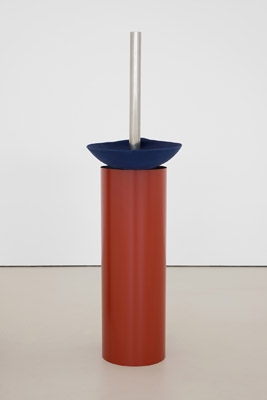

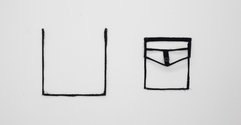
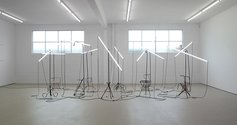
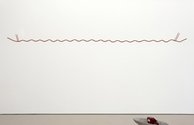
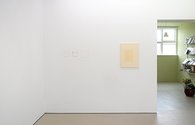
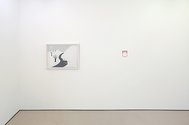

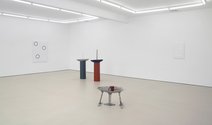
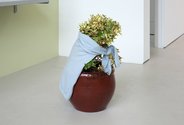
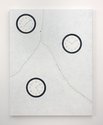

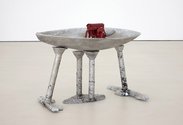
 Advertising in this column
Advertising in this column Two Rooms presents a program of residencies and projects
Two Rooms presents a program of residencies and projects



This Discussion has 0 comments.
Comment
Participate
Register to Participate.
Sign in
Sign in to an existing account.